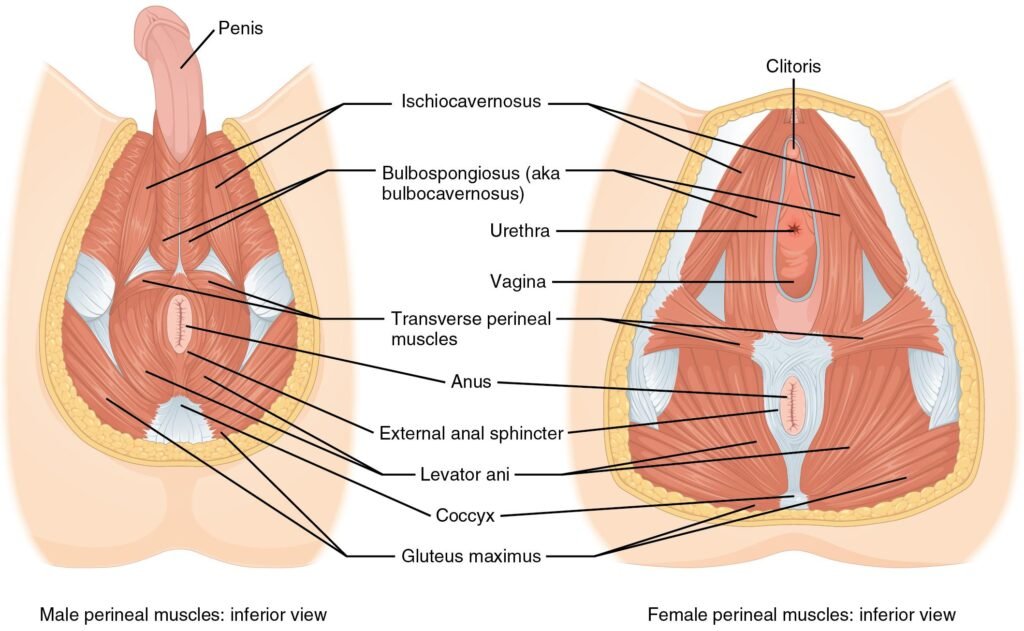In a world where the conversation around health is becoming increasingly open and inclusive, one topic remains shrouded in misunderstanding and stigma: pelvic floor dysfunction. Often whispered about in hushed tones, this condition affects countless individuals yet remains underrepresented in discussions of overall well-being. But what if we told you that change is on the horizon? In an enlightening interview, Dr. [Name], a leading expert in pelvic health, emphasizes a powerful message: pelvic floor dysfunction is not only common, but it is also ”always treatable.” By prioritizing our health and breaking the silence surrounding this issue, we can empower ourselves and others to seek solutions. Join us as we delve into the insights shared by Dr. [Name], illuminating the path toward understanding, treatment, and ultimately, a healthier future.
Understanding Pelvic Floor Dysfunction and Its Symptoms
Pelvic floor dysfunction occurs when the muscles and ligaments that support the pelvic organs become weak, tight, or damaged, leading to a variety of challenges in daily life. This condition often manifests through a range of symptoms that can significantly impact one’s quality of life. Individuals may experience:
- Urinary issues: Incontinence, urgency, or difficulty starting or stopping the flow of urine.
- Fecal dysfunction: Constipation, fecal incontinence, or a sense of incomplete evacuation.
- Pelvic pain: Discomfort or pain in the lower abdomen or pelvic region.
- Sexual dysfunction: Pain during intercourse or loss of libido.
- Prolapse: A feeling of heaviness or bulging in the pelvic area.
Recognizing these symptoms early can facilitate effective treatment and management, steering individuals toward better pelvic health. Lifestyle modifications, pelvic floor therapy, and in some cases, medical interventions can aid in alleviating these symptoms. Below is a simple overview of common treatment options:
| Treatment Option | Description |
|---|---|
| Pelvic Floor Exercises | Targeted exercises to strengthen pelvic muscles. |
| Biofeedback | Using technology to improve awareness and control of pelvic muscles. |
| Cognitive Behavioral Therapy | Addressing anxiety or depression that may stem from dysfunction. |
| Medication | Managing symptoms through prescribed treatments. |
| Surgery | Considered for severe cases or anatomical abnormalities. |

Empowering Patients: The Importance of Seeking Help
In the journey toward better health, it’s crucial for patients to understand that seeking help is a sign of strength, not weakness. Many individuals suffering from pelvic floor dysfunction may feel hesitant or embarrassed to talk about their symptoms, which can include anything from urinary incontinence to pelvic pain. However, reaching out to a healthcare professional can be the first step toward reclaiming control over one’s health. It’s essential for patients to remember that they are not alone; support and treatment options are available that can lead to significant improvements in quality of life.
When patients decide to open up about their experiences, they pave the way for a more informed healthcare dialogue. This proactive approach can lead to several benefits, including:
- Personalized Treatment Plans: Health professionals can tailor their recommendations based on individual needs.
- Access to Resources: Patients become aware of various therapies and support groups that can assist in managing symptoms.
- Increased Awareness: By discussing pelvic floor dysfunction, patients can help destigmatize the condition for others.
Remember, taking the first step to seek help can be transformative. Each story shared can inspire others and contribute to a supportive community where everyone feels empowered to prioritize their health.

Innovative Treatment Options for Lasting Relief
Healthcare professionals are continually discovering groundbreaking methods to manage pelvic floor dysfunction, emphasizing the idea that effective relief is often within reach. Patients can explore a variety of innovative therapies designed to restore function and enhance comfort. Methods such as:
- Biofeedback Therapy: A non-invasive approach that helps patients gain awareness and control over their pelvic muscles.
- Pelvic Floor Physical Therapy: Tailored exercise regimens that strengthen pelvic muscles and alleviate symptoms.
- Neuromodulation Techniques: Advanced procedures that target nerve pathways to improve pelvic function and reduce discomfort.
Moreover, advancements in technology are enabling more personalized care options for those suffering from these issues. Incorporating tools like:
| Innovation | Description |
|---|---|
| Wearable Devices | Track pelvic muscle activity to guide rehabilitation efforts. |
| Telehealth Consultations | Access to specialized care from home, improving patient engagement. |
These treatments not only contribute to immediate relief but also promote ongoing health and well-being, encouraging patients to prioritize their pelvic health and reclaim their quality of life.

Prioritizing Self-Care: Strategies for a Healthier Pelvic Floor
Taking the time to prioritize self-care is essential for maintaining a healthy pelvic floor. By incorporating daily practices into your routine, you can elevate your overall well-being and support pelvic health. Consider these effective strategies to nurture your body:
- Mindful Movement: Engage in gentle exercises such as yoga or Pilates, which can help strengthen pelvic muscles while promoting relaxation.
- Breathwork: Practicing deep breathing techniques can help alleviate tension in the pelvic area and encourage relaxation.
- Hydration: Staying well-hydrated supports bodily functions and can prevent issues related to bladder health.
- Nutrition: Focus on a balanced diet rich in fiber to promote healthy digestion, as this can have a significant impact on pelvic floor health.
Additionally, it’s beneficial to incorporate some self-reflection techniques into your routine. Journaling or engaging in mindfulness practices can help you tune into your body’s needs and foster emotional well-being. The following table outlines some simple yet impactful self-care activities you can implement:
| Activity | Frequency | Benefits |
|---|---|---|
| Gentle Yoga | 3-4 times a week | Enhances flexibility and strength |
| Deep Breathing | Daily | Reduces stress and tension |
| Hydration | All day | Improves bladder function |
| Mindfulness Journaling | Weekly | Boosts emotional clarity |
Q&A
Q&A: Understanding Pelvic Floor Dysfunction and Prioritizing Your Health
Q1: What is pelvic floor dysfunction, and how does it manifest?
A1: Pelvic floor dysfunction refers to a range of issues in which the pelvic muscles are too tight, weak, or unable to coordinate properly. Symptoms can vary widely, including urinary incontinence, pelvic pain, pain during intercourse, and issues related to bowel movements. It can affect people of all ages and can stem from a variety of causes, including childbirth, surgery, aging, or even chronic stress.
Q2: Why is it important to prioritize health when dealing with pelvic floor dysfunction?
A2: Prioritizing your health is crucial because pelvic floor dysfunction can have a significant impact on daily life, emotional well-being, and overall quality of life. Addressing these issues promptly with professional help ensures that individuals can regain control and improve their physical and emotional health. Ignoring symptoms can lead to further complications and discomfort.
Q3: What does the term ‘always treatable’ mean in the context of pelvic floor dysfunction?
A3: When our expert says that pelvic floor dysfunction is ‘always treatable,’ it emphasizes that there are effective interventions available for everyone experiencing these issues. Treatment may involve pelvic floor therapy, lifestyle changes, or even surgical options, depending on the severity and underlying causes. Each individual’s journey is unique, but there are solutions tailored to meet their specific needs.
Q4: Can you outline the types of treatments available for pelvic floor dysfunction?
A4: Certainly! Treatments can include:
- Physical Therapy: Specialized pelvic floor physical therapists help strengthen or relax pelvic muscles through targeted exercises.
- Biofeedback: This technique helps individuals understand and control their pelvic muscles through real-time feedback.
- Medications: Certain medications can help manage symptoms, particularly in cases where inflammation or excessive muscle tension is involved.
- Surgery: For severe cases, surgical options may be explored, especially if there are anatomical issues contributing to dysfunction.
- Lifestyle Changes: Incorporating diet modifications, exercise, and stress management techniques can also play a vital role in treatment.
Q5: What should someone do if they suspect they have pelvic floor dysfunction?
A5: The first step is to consult a healthcare professional who specializes in pelvic health. They can assess the symptoms, conduct necessary evaluations, and guide you toward the appropriate treatment options. It’s important to approach this with an open mind and avoid any feelings of shame or embarrassment—this is a common health issue that many people face.
Q6: Are there any misconceptions about pelvic floor dysfunction that need to be addressed?
A6: Yes, one significant misconception is that pelvic floor dysfunction only affects women or those who have given birth. In reality, it can affect anyone, including men and individuals who have never been pregnant. Additionally, many people believe that it’s an inevitable part of aging, but while it can be more prevalent in older adults, it is not a normal aspect of aging and can always be addressed.
Q7: How can someone make a commitment to prioritize their pelvic health?
A7: Making a commitment to prioritize pelvic health begins with education—understanding the importance of the pelvic floor and recognizing symptoms. Regular check-ups, open discussions with healthcare providers, and being proactive in seeking treatment are crucial. Furthermore, integrating self-care practices, such as mindfulness and relaxation techniques, can support overall well-being.
Q8: In what ways can society further support individuals with pelvic floor dysfunction?
A8: Society can play a pivotal role by promoting awareness and normalizing conversations around pelvic health. Educational campaigns, supportive community resources, and accessible healthcare services can break down stigma and encourage individuals to seek help without fear of judgment. This cultural shift can empower countless others to prioritize their health and seek the help they deserve.
Future Outlook
prioritizing your health is not just a choice; it’s a necessity. As we’ve explored through the insights of the expert discussing pelvic floor dysfunction, the message is clear: no matter the severity of your condition, there is hope and a path toward healing. By embracing open conversations about our bodies and seeking professional guidance, we empower ourselves to reclaim our well-being. Remember, awareness is the first step toward action. Whether through lifestyle changes, therapy, or medical intervention, it’s never too late to put your health first. So, take that courageous step forward, listen to your body, and know that support and solutions are always within reach. Your journey to better health starts today.

